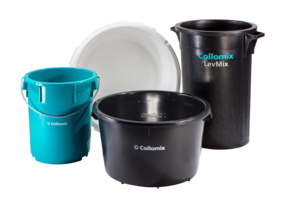
XM 2-650 -Forced-Action-Mixer
Installation of precast concrete components for heavy-duty rail traffic
Impressive use of Collomix mixing technology with multi-component-flowable grouting mortar and forced-action mixer XM 2-650
The traffic project "Turning Loop Leutewitz" for the streetcar of the "Dresdner Verkehrsbetriebe" was completed in summer 2020. The contractors were commissioned with the fundamental development of the turning loop, which was performed using what is known as the “slab track technique”.


Flowable epoxy grout ensures strength of highly stressed concrete elements
Two tram stops, among other things, are provided in the turning loop area. Concrete elements, called “Dresden Combibords”, were installed within the stops. These special edging boards were first used by the Dresdner Verkehrsbetriebe as a structural engineering solution for stops to allow passengers to board and disembark the vehicles safely at the same level.
To ensure that the Combibords withstand the high mechanical loads exerted on them, they are fixed in place with an epoxy resin-based, heavy-duty grouting mortar after being fitted. The flowable mortar spreads over the entire surface under the concrete components and provides a cavity-free connection to ensure the require strength of the concrete elements. The contractors chose to use the 3-component high-performance mortar ASODUR-EV-DCB manufactured by Schomburg here. This high-performance mortar was developed, among other things, for the “Dresden Combibords” and fulfils the high demands on mechanical strength, good adhesion to concrete and steel, water resistance, and good flow properties. The self-levelling mortar can also be worked in layers from 10 mm to 200 mm thick.
During implementation, it was possible to pour out a total of around 110 running metres of concrete elements with spaces up to 80 cm wide and a layer thickness of 25 to 45 mm in the area of the stops within two days. This corresponds to a processing volume of around 7 tonnes and around 120 material mixes. The companies Collomix and Schomburg analysed the requirements on the mixing technology in advance. It was decided to use the forced-action mixer XM 2-650 from Collomix to mix the resin/hardener mixture with the bulking agent. The decision-makers involved were convinced that the Collomix mixing principle, the ease of use of the equipment and the automatic monitoring of the mixing time would make the work significantly easier overall.

Premixed resin is added to the agent in the mixer

Perfectly mixed grout

Pouring the grout into the cavities
The correct selection of mixing tools for the XM is of decisive importance for the result
During the first operation step, the two liquid resin and hardener components were thoroughly premixed in a separate container using a Collomix hand mixer with the appropriate DLX paddle. This is essential to ensure that the constituents are completely mixed up with each other in the right ratio. Hand mixing with the bulking agent was generally not an option due to the volume of material and the necessary process reliability. It is crucial that the mixing process has a high degree of repeat accuracy in order for the mortar to have a consistent processing quality. Flow characteristics, the reaction time of the material and residue-free preparation are crucially influenced by the mixing technology. As a result, the Collomix XM 2-650 mixer with active double mixing tools and an edge scraper, which prevents material deposits at the edge of the bucket, was selected. The mixing process is controlled with the help of a timer to ensure that the necessary mixing time is observed precisely. For each mixture, two units of the bulking agent were added to the mixer together with the corresponding quantity of the resin mixture, a total of 60 kg, and fully mixed in 180 seconds. Due to the high quality of the mixing, there was no need to transfer the material and mix it up again.
The removable mixing bucket of the Collomix forced-action mixer, which could be transported directly to the processing site with the help of a trolley, proved advantageous and reduced the workload significantly. The mortar was filled directly into the grouting aids, which also allowed the material to be applied cleanly without wastage. Rapid processing of the mortar was required due to the pot life. As freshly mixed material was supplied without any interruption, the method functioned seamlessly.
The high processing quality of the material and the consistent mixing result impressed the tradespeople and technicians involved. The speed at which the mixed material was available was equally impressive. The people involved found the physical relief resulting from the use of the Collomatic XM2-650 forced-action mixer as a mixing solution to be extremely pleasant.




